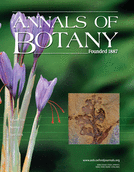
|
|
Karremans, A.P., F. Pupulin, D. Grimaldi, K.K. Beentjes, R. Butot, G.E. Fazzi, K. Kaspers, J. Kruizinga, P. Roessingh, E.F. Smets & B. Gravendeel. 2015. Pollination of Specklinia by nectar-feeding Drosophila: the first reported case of a deceptive syndrome employing aggregation pheromones in Orchidaceae. Annals of Botany 2015: 1-19. doi: 10.1093/aob/mcv086
Background and Aims. The first documented observation of pollination in Pleurothallidinae was that of Endre´s, who noticed that the 'viscid sepals' of Specklinia endotrachys were visited by a 'small fly'. Chase would later iden- tify the visiting flies as being members of the genus Drosophila. This study documents and describes how species of the S. endotrachys complex are pollinated by different Drosophila species.
Methods. Specimens of Specklinia and Drosophila were collected in the field in Costa Rica and preserved in the JBL and L herbaria. Flies were photographed, filmed and observed for several days during a 2-year period and were identified by a combination of non-invasive DNA barcoding and anatomical surveys. Tissue samples of the sepals, petals and labellum of Specklinia species were observed and documented by SEM, LM and TEM. Electroantennogram experiments were carried out on Drosophila hydei using the known aggregation pheromones ethyl tiglate, methyl tiglate and isopropyl tiglate. Floral compounds were analysed by gas chromatography–mass spectometry using those same pheromones as standards.
Key Results. Flowers of S. endotrachys, S. pfavii, S. remotiflora and S. spectabilis are visited and pollinated by several different but closely related Drosophila species. The flies are arrested by aggregation pheromones, including ethyl tiglate, methyl tiglate and isopropyl tiglate, released by the flowers, and to which at least D. hydei is very sen- sitive. Visible nectar drops on the adaxial surface of sepals are secreted by nectar-secreting stomata, encouraging male and female Drosophila to linger on the flowers for several hours at a time. The flies frequently show courtship behaviour, occasionally copulating. Several different Drosophila species can be found on a single Specklinia species.
Conclusions. Species of the S. endotrachys group share a similar pollination syndrome. There seem to be no spe- cies-specific relationships between the orchids and the flies. It is not expected that Specklinia species will hybridize naturally as their populations do not overlap geographically. The combination of pheromone attraction and nectar feeding is likely to be a generalized pollination syndrome in Pleurothallidinae.
Key words: Aggregation pheromones, courtship, deceit, deceptive pollination syndrome, Drosophila repleta group, nectar-secreting stomata, Orchidaceae, Pleurothallidinae, pollination biology, Specklinia endotrachys, Specklinia pfavii, Specklinia spectabilis, Specklinia remotiflora.
PDF [2.8 MB] |

